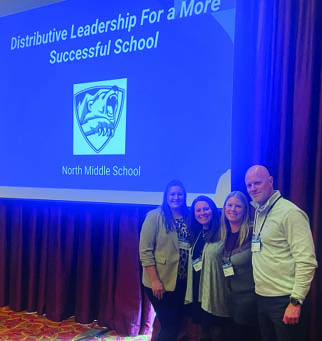Viewpoint: May 2023
Schools are complex systems, whether urban, rural, or suburban. One way to ensure that a complex system works effectively is for all staff to be aligned in working toward meeting the school’s goals and achieving its mission. Collective efficacy is one term for the shared conviction that educators working together can help raise student achievement.
In many schools, the traditional approach where the principal and assistant principal lead every meeting, set the agenda, develop the accountability structure, and engage in all the classroom observation and feedback still prevails. That looks more like a model where compliance is the goal, without true authentic engagement.
At North Middle School in Aurora, CO, I’ve followed the more collective approach using the strategy of distributed leadership. As the name implies, this strategy centers on teams made up of various members of a school community, with the work shared so it doesn’t fall solely on one person’s shoulders (usually the principal’s). We want multiple stakeholders—from the administrators to the teachers and other staff to the students—to be involved. That doesn’t mean that everyone must take on leadership roles, because that would be unrealistic. But it does mean far more opportunities for those who are interested—especially teachers.
Turning Things Around
We’ve seen a lot of changes over the past five years at our school. When I started, it was a turnaround school, and there was a lot of staff churn. As a result, I did not fully engage in distributed leadership practices immediately. We did have to begin with a top-heavy approach to leadership as we set clear goals and evaluated staff to see where they were. We worked with them so they could take on more of a leadership role in helping the school reach those goals. Now we’re at the point where the leadership approach is more teacher-centric, with our teachers having more influence over all key decisions. We work together to achieve the collective efficacy I mentioned at the start.
We have two primary teams at North Middle School: Content teams (that focus on instructional planning, data-driven instruction, assessment development, professional development, and curriculum implementation) and grade-level teams (that focus on cross-curricular grade-level student supports, as well as academic, attendance, social-emotional, and behavioral interventions). The teams meet weekly with the overall aim of supporting our two main school goals, one on improving instruction and the other on student climate and culture.
Each team is led by a teacher who is vetted through a team interview to make sure they are aligned with our school’s purpose and have the skills to lead and facilitate a team of teachers. In other words, our teacher leaders need to know exactly what is being distributed. We are very clear on what we’re looking for and how those positions align with schoolwide goals. It’s important to make the selection process transparent so everybody knows they can apply.
We all know educators are not well-compensated, and with distributed leadership we’re asking people to take on extra work. They do get a $900 stipend, but that is very modest, especially after taxes.
Little Resistance to Change

One thing that distributed leadership naturally brings is more meetings. But I can honestly say there’s not a lot of resistance to this. That doesn’t mean everyone is excited to be there at 7:30 in the morning, but they see the benefit of the meetings. Nobody misses these meetings, and nobody asks if we have to meet. Our staff members see the value of these meetings because they are teacher-led. There is ample opportunity for teacher voice and feedback. They also appreciate the meetings because what we discuss is tied directly to what the teachers are doing in their classrooms.
I like to collect data on staff attitudes, and I’m happy with the results. For example, more than 85% of our staff say that teachers and support staff have adequate influence on important school decisions and feel comfortable raising any concerns they have. They feel that teachers are empowered to lead and that they have input, especially around their professional learning.
The other change I’m pleased with is lower turnover. Before I came to North, the staff retention rate was about 60%. We still have some staff leave every year, but we’ve retained more than 85% of our certified staff over the past three years. And staff attendance is well above 90%, including during COVID when staff absences nationwide reached an all-time high. I think these figures are directly related to our positive working conditions and the value we place on teacher leadership to help all our teachers improve. Our teacher teams are trusted to do their work so that our administration can work alongside teachers, rather than managing or directing their work.
Student Success as the Goal
All that change doesn’t mean much if our students aren’t achieving what we expect from them. With COVID, there was so much volatility in the learning environment, especially when instruction was remote. But in terms of student attendance, student behavior, and student achievement, we’ve seen a lot of growth. For the 2021–22 school year, for example, North Middle School had the highest overall math growth among middle schools in the district, and the second highest in reading. We’ve also exited more English learners than ever before from our programs designed to meet their needs. And we’ve reduced the number of discipline referrals for students of color by well over 50%.
The final piece to rebuilding collective efficacy is meaningful staff recognition and ongoing feedback. As a school leader, you must recognize staff for the work they do, and it should be done in a formal way with actual awards.
This is purpose-driven work, and our staff does it because they believe in the mission. In our school, we celebrate our bright spots, successes, and progress. We really try to keep that positive focus because, as everyone in education knows, this is hard work.
Brian Duwe, PhD, is the principal of North Middle School in Aurora, CO. He will co-present a session on distributed leadership at Ignite 2023 in July.
Sidebar: Distributed Leadership in Your School

If you are thinking about developing distributed leadership practices in your building, consider these action steps:
- Ensure that you have collectively developed a school mission statement.
- Remember to collectively develop core values, too, that support the mission statement. Doing so clarifies what is most important for your staff to uphold in terms of behaviors and beliefs.
- Prioritize a few (two or three) high-leverage goals to keep your staff aligned and focused.
- Once you have established a few SMART (specific, measurable, attainable, relevant, time-bound) goals, align your teams to support the work in meeting those goals.
- Create a process to hire teacher leaders who have the efficacy, confidence, and the necessary skill sets to effectively lead a team of teachers.
